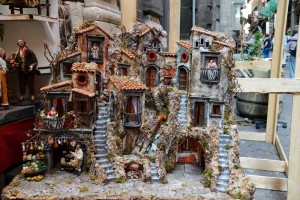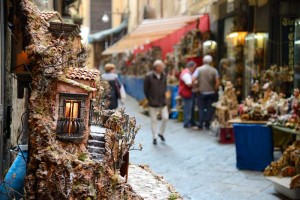According to legend, Saint Francis of Assisi asked a man called Giovanni Vellita to build the first nativity set in the 13th century. This holy scene served as backdrop for his Christmas mass. Nativity sets had already spread all over Italy only a few years later with the oldest written documentation of production dating back to 1384. Today you find nativity sets in many countries around the globe. One of the most famous such scenes has its origins in Naples, where there’s even a special street dedicated to these sets.
What makes the Neapolitan nativity set so special?

©Bigstock.com/Photostickers
Building such a set is regarded as a craft in Naples, which is still practised in many places. A classic Neapolitan nativity set shows the everyday life of the public in the 18th century, even though religious scenes are pushed into the background. You get to see the cooking farmer’s wife, the pizza baker at the wood stove or a laundress performing her duty, for example. Infant Jesus and his family are depicted as well and assume a prominent role, yet they don’t take centre stage.
When is the nativity scene set up?
Christmas tree or nativity set – a question of principle for many Italian families that can lead to arguments. Whatever dominates the living rooms is usually set up on December 8th. Infant Jesus, however, shouldn’t be put into the set before midnight between December 24th and 25th. The Christmas tree as such is a comparatively young tradition and only entered the homes of Italian families in the 1950s. These days you frequently find both a tree and a nativity set in living rooms from north to south.
Naples’ nativity street

©Bigstock.com/Photostickers
There are many builders of nativity sets in Naples, but one street in particular is widely regarded as the home of this immensely beautiful craft. Numerous shops and studios offering sets, figurines and accessories line Via San Gregorio Armeno in the historic city centre. It is known as nativity street with good reason. The Via is all about classic Neapolitan nativity sets. You won’t just find depictions of the Holy Family and the Magi, but also those figurines that are typical for Naples’ early city life: fishmongers and fruiterers, washers, bakers, butchers, farmers, or chestnut vendors. Hand-carved masterpieces and colourful plastic figurines join the classic Neapolitan talismans corni – red horns that supposedly protect from evil looks. In Advent season, Via San Gregorio Armeno turns into the city’s largest Christmas market.
Nativity set exhibition at the Museum of San Martino
You’d like to learn more about the history of Neapolitan nativity sets and see some of the most beautiful examples from up close? Then it’s off to Castle Sant’Elmo on the eponymous hills in the district of Vomero, home to the Monastery and Museum of San Martino (Certosa e Museo di San Martino), where the most important collection of Neapolitan nativity sets in all of Italy is housed. The large nativity set Cucinello is probably the most famous exhibit. It was consecrated in 1879 and named after Michele Cucinello, who bequeathed his collection with approx. 800 figurines to the city of Naples. Different ways of lightning simulate the times of day in this nativity scene set in a reproduced grotto. The museum is also home to numerous works of art from different eras of the city, which are just as worth seeing as the terraced garden of the monastic complex.
If you are interested in nativity sets, you absolutely have to visit Naples. Here you get to experience various modes of this Christmas tradition between old customs and modern influences. Plan your trip to Italy with ZAINOO – here you find the best suggestions for your next holiday!